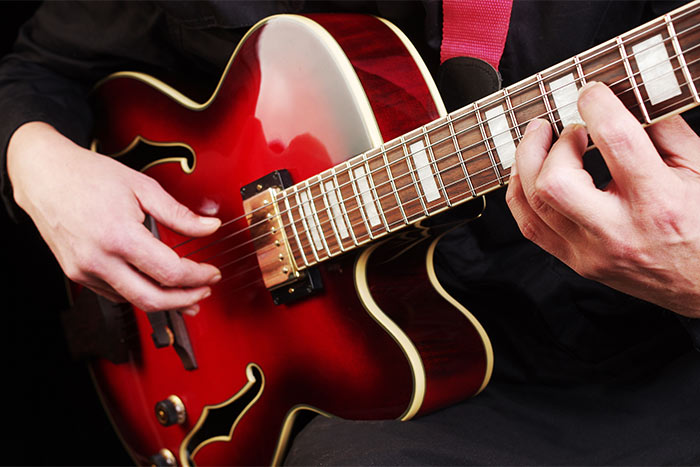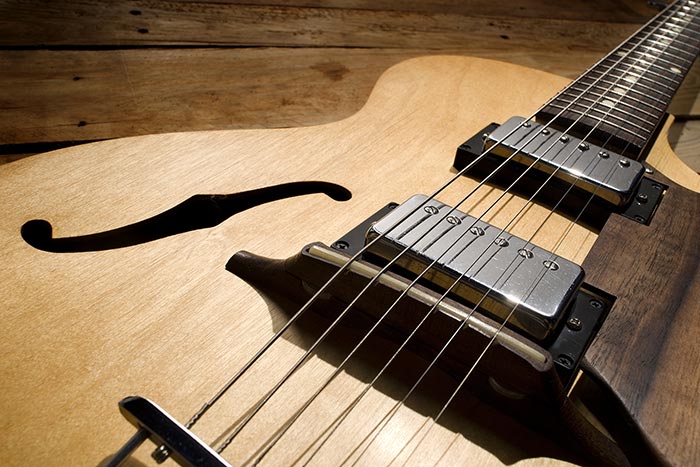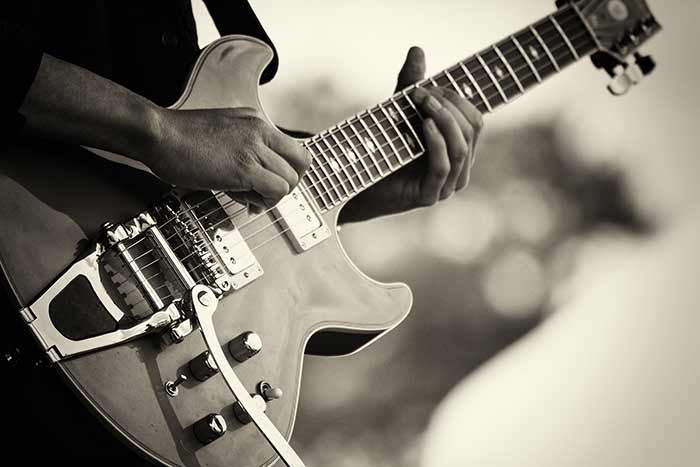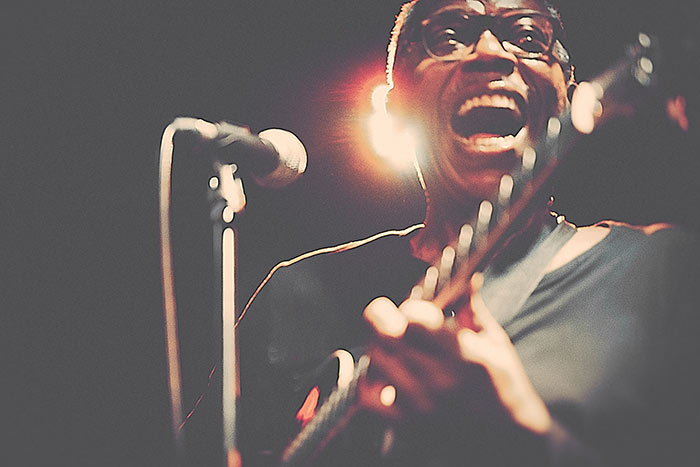Many rock guitarists may, at some point in their musical journey, feel the need to learn jazz, which can appear quite daunting initially. The good news is, that you are able to use your existing knowledge of rock guitar to start you off on your jazz guitar journey!

Scales
Like with any style of music, scales will be a fundamental piece of knowledge that feeds into every aspect of your playing. This will particularly help with the theory side of jazz guitar playing, as you could argue that jazz guitar is much more theory-based than rock guitar. In rock, we play a lot ‘by ear’ or ‘by feel’, often using one blanket pentatonic scale to solo throughout the entire chord progression. In jazz, we play it much more chord-by-chord, sometimes having to change scale or arpeggio (more on this in a minute) every chord change! A great place to start with scales will be the modes of the Major scale. These are:
- Ionian (Major)
- Dorian
- Phrygian
- Lydian
- Mixolydian
- Aeolian
- Locrian
Each of these notes is built off of the notes of the Major scale (or Ionian mode). For example, the C Major/Ionian will be playing notes from C to C with no accidentals. D Dorian will be playing notes from D to D with no accidentals, E Phrygian will be playing notes from E to E with no accidentals ect. Even though all of these scales/modes contain the same notes, they will each have their own unique sound when played in context, especially over the appropriate chords that they fit with. Start off your jazz guitar journey by learning these modes of the Major scale in all positions of the neck.
Arpeggios
Once you have a good grasp of the Major scale, this will help a lot with learning the mechanics of arpeggios. The definition of the word “arpeggio” means to play notes separately one after another rather than all together at once in a chord, so it literally just means to play a broken chord. We can also think of an arpeggio as a scale with particular notes taken out.
For example, a C Major 7 arpeggio will be the 1 – 3 – 5 – 7 from the Major scale, played separately one after another. There are four main types of arpeggios that you can focus on when starting your guitar journey, which can be created using the following formulas and altering notes found in the Major scale that we have already learned:
MAJ 7: 1 – 3 – 5 – 7
DOM 7: 1 – 3 – 5 – b7
MIN 7: 1 – b3 – 5 – b7
MIN 7 (b5): 1 – b3 – b5 – b7

Chords
Jazz will contain many more chords than we are used to in rock, usually in the form of 7th chords. These can then be further extended up using 9ths, 11ths, and 13ths, and then from there, altering other notes in the chords to create more dissonant sounds.
Start with building up your chordal library with Major 7th, Minor 7th, Dominant 7th, and Minor 7 (b5) chords (just like the arpeggios!) in multiple positions on the neck, which should cover you in most situations. Even more complicated chords can be simplified down to one of these four chords in the beginning!
Also, be sure to check out our article “Jazz guitar chords for beginners: how to jazzify your chords and get started with jazz!”.
Playing over chord changes
As we already hinted at earlier, jazz guitar will involve a different way of thinking when playing, which is much more chord-by-chord rather than just the overall key. We will often have to ‘play over changes’, which means we target notes in each chord using arpeggios to hit the important chord tones so that we can follow these chord changes.
This can be quite difficult in the beginning, as we need to be comfortable with all of our scales and arpeggios all over the neck in order to think quickly enough to play these successfully. Sometimes, the chords can change multiple times per bar, so slow practice going through all of the arpeggios needed will be important to successfully playing the changes.

Improvisation
Arguably, the biggest part of being a jazz musician is improvisation, which is a concept that we are somewhat familiar with in rock! Depending which sub-genres of rock you are into, you may already have some experience with improvising. Blues/blues-rock will be big on improvising, which we follow more or less the same approach as in jazz.
We have already spoken about playing over chord changes and using arpeggios, etc., but a big part of improvising in any genre will be to make your solos sound like melodies rather than just playing arpeggios up and down, which can just sound like a warm-up exercise.
To create more of a melodic and memorable solo, try following these simple tips:
USE REPETITION – a solo or melody can’t really be memorable unless there is some element of repetition to it. Pick a simple phrase to repeat a few times around, sometimes with different variations to keep it interesting.
LEAVE SPACE – imagine if you spoke constantly with no pauses in your sentences or if you were reading a book that had no full stops/periods or commas. Exhausting! Your solos will be exactly the same. The phrase that you just played will have much more impact when you leave a gap at the end, letting the listener digest what you just played.
PLAY FRAGMENTS OF THE SCALES – even though we don’t want to sound like we are playing a warm-up exercise, we still need to play fragments of the scales in order to sound melodic. Try the first 4 or 5 notes of a scale, then pause or change rhythmically to create some difference from the original scale.
Enjoyed this jazz guitar guide? Good news!
We have another in-depth article on the topic. Take a deeper dive into the world of jazz guitar with our additional guide – waiting for you to explore! Click here to read more.







